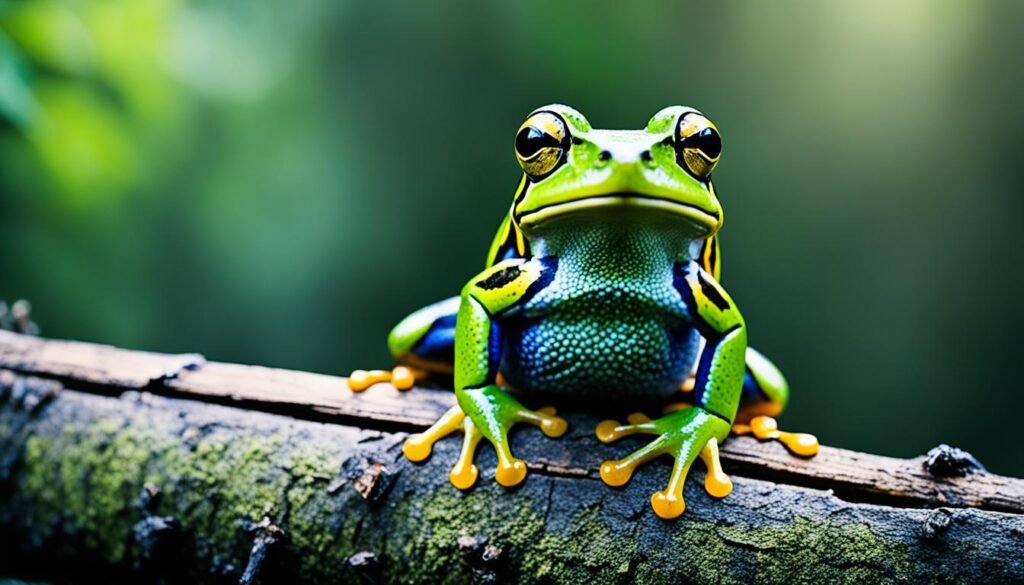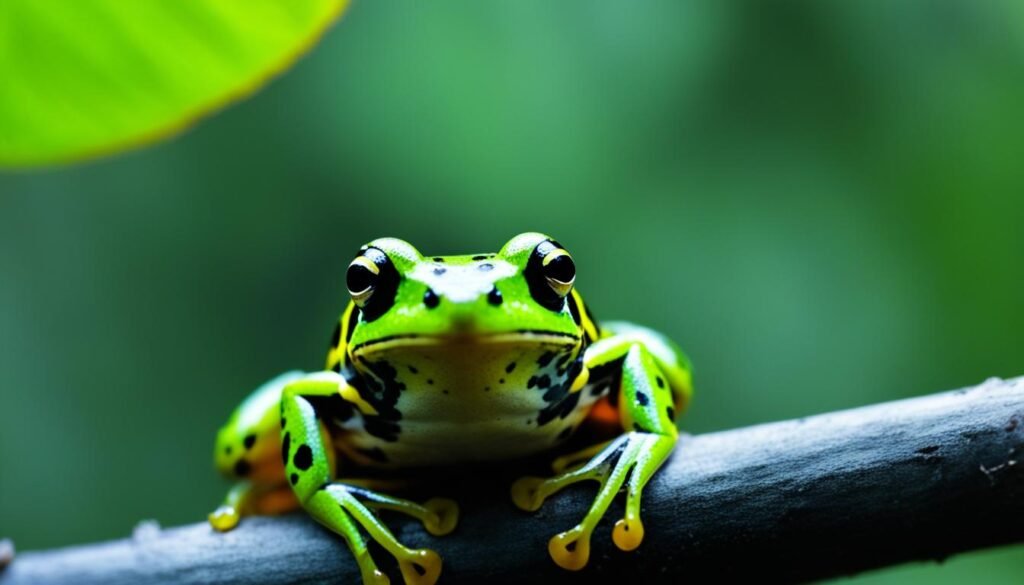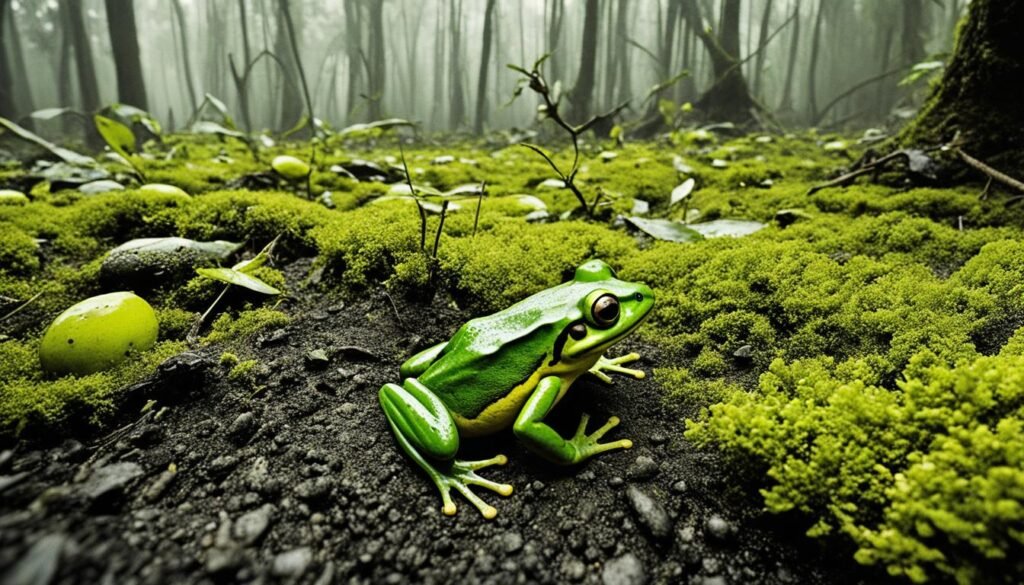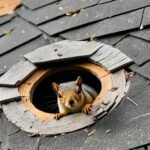Frogs play a big role in showing how our environment is doing. They are very sensitive to changes around them. For example, they start as tadpoles with internal gills and then turn into endangered frog species with lungs. They can live in water and on land. But, their homes are being destroyed because of farming and other human actions. This is why we need to work hard to save them.
There are over 6000 frog species around the world. 42% are mostly on land, 29.2% live in water, and 28.8% can do both. Sadly, over 2500 frog types are not doing well. South America has the most variety, with 905 types. Asia follows with 573, and Africa has 482 species.
Frogs are losing their homes in places like Colombia, Madagascar, and Ecuador. About 8.6% are in very big danger, 14% are at risk, and 9.5% are closely followed. Countries like Colombia, Mexico, Ecuador, and Haiti have many of these very endangered frogs.
Introduction to Endangered Frog Species
Amphibians like frogs are key to our ecosystems, giving us clues about the environment’s health. Almost a third of these species face extinction, highlighting the need to study them. They’re unique since they can live in both water and on land, showing their special but fragile nature.
What Makes Frogs Unique?
Frogs are special because they can breathe through their lungs and skin. This ability helps them stay moist and survive in various places. But, it also means they are deeply affected by issues like destroyed habitats and pollution.
The Role of Frogs in Ecosystems
Frogs are crucial for keeping ecosystems healthy. They eat insects and are food for other animals, balancing the ecosystem. The chytrid fungus has caused a major decrease in 200 frog types. For example, the Macaya Breast-spot Frog’s population is expected to drop by 80% in the upcoming years.
| Frog Species | Current Status | Main Threat |
|---|---|---|
| Macaya Breast-spot Frog | Critically Endangered | Habitat Destruction |
| Kihansi Spray Toad | Extinct in the Wild | Hydroelectric Dam Construction |
| Island Forest Frog | Critically Endangered | Human Encroachment |
| Golden Mantella | Critically Endangered | Habitat Loss |
| Titicaca Water Frog | Critically Endangered | Over-Harvesting, Invasive Species |
The planet is seeing huge losses in frog numbers, with the Titicaca Water Frog’s population dropping by 80%. This shows why we must work hard to save them. Protecting their homes and knowing the part they play in their ecosystems is vital to stop biodiversity loss.
Threats to Frog Populations

Endangered frogs face many serious threats today. These dangers make it more important than ever to protect them. Major threats come from losing their homes, pollution, climate change, and diseases like the chytrid fungus. These issues harm frogs all around the world.
Habitat Loss
Frogs are losing their homes at an alarming rate. This happens because of actions like farming, building cities, and choosing not-so-good ways to use land. For example, in Washington state, special frogs like the Oregon Spotted Frog and Northern Leopard Frog see their homes getting worse. Due to these changes, frogs like the Western Toad and Larch Mountain Salamander are in danger according to the IUCN.
Pollution and Climate Change
Pollution and a changing climate are big problems for frogs. Their skin easily absorbs harmful substances from water and land. Changes in the climate also mess up where they can live and how they grow. From 2004 to 2022, 39% of frog species said that climate change is their biggest threat. With changing rain and warmth, many frog homes are in trouble, making it really hard for them to survive.
Chytrid Fungus and Other Diseases
Diseases like the chytrid fungus are causing a lot of trouble for frogs. This fungus has spread to five continents and is very deadly. Over 8,000 frog species are at a big risk because of this disease. The continued spread of diseases is really bad news for frogs worldwide, leading many to face the risk of disappearing forever.
The Impact of Climate Change on Frog Species
Frog populations are very sensitive to changes in their environment. This makes them extra vulnerable to climate change effects. We’ll look at how temperature and precipitation changes affect these amphibians.
Temperature Changes
Rising global temperatures greatly affect frog species. They can mess up when frogs breed and how fast they grow. This can lead to not enough of their necessary resources being available. For example, the foothill yellow-legged frog, protected under the Endangered Species Act in 2023, is at more risk from droughts and higher temperatures. These issues increase the chances of them getting sick from Batrachochytrium dendrobatidis (Bd).
For about 120 years, scientists have mapped disease patterns relating to frogs. They connected the dots between temperature increases and frogs getting sick from diseases like Bd. Advanced statistical models showed this clearly.
Changes in Precipitation
Changes in rainfall patterns because of climate change are also a big danger for frogs. Different rain can mess up where frogs live and the water they need. This can harm the growth of frog larvae. Imagine how the foothill yellow-legged frog and its habitat are affected. Land changes for farming, brought by weird rainfall patterns, make it worse for them.
Through teamwork, research by University of California, Berkeley, U.S. Geological Survey, and Florida International University shows that understanding these rain changes is key. This helps scientists find ways to protect frog communities.
Case Studies of Critically Endangered Frog Species

Critically endangered frog species show us the need for fast conservation efforts. They highlight actions crucial to prevent amphibian extinctions. Here, we discuss the Panamanian golden frog, Kihansi spray toad, and dusky gopher frog. We look at the necessary steps to save them.
Panamanian Golden Frog
The Panamanian golden frog is in big trouble. It’s found only in Panama and is at risk due to a disease. Called chytridiomycosis, this fungal disease is spreading. It is causing many frogs around the world to disappear. In Panama, projects are working hard to save them. They have over 400 frogs and toads in other areas, like Madagascar, safe from this disease. This shows just how important their work is.
Kihansi Spray Toad
In Tanzania, the Kihansi spray toad almost disappeared because of a dam and lost homes. But, efforts have helped them return to the wild. This work includes breeding them in safety. They are fighting against the disease that puts these animals at risk. Such efforts are not only to save this toad but to help other frogs too.
Dusky Gopher Frog
In the United States’ southeast lives the dusky gopher frog. It is almost gone because of lost homes and disease. People are working hard to keep its places safe and help them make more frogs. They want to overcome the challenges many endangered frogs face. The dusky gopher frog’s story is key to understanding the big issue around saving these animals.
| Species | Conservation Focus | Geographical Range |
|---|---|---|
| Panamanian Golden Frog | Assurance Colonies | Panama |
| Kihansi Spray Toad | Captive Breeding and Reintroduction | Tanzania |
| Dusky Gopher Frog | Habitat Restoration | South-Eastern USA |
Conservation Strategies for Endangered Frog Species
To tackle the serious decline of endangered frogs, we use a mix of strategies. These include fixing habitats, breeding programs, and making strong laws.
Habitat Restoration
Restoring homes for frogs is key. We help by fixing the land broken by cities and farms. This work is crucial because things like Atrazine can turn frogs into both sexes. We work hard to repair wetlands and forests near water. Stopping trout from eating frogs also helps these areas get better.
Captive Breeding Programs
Keeping some frogs safe in zoos is crucial. Places like AZA zoos have plans to save certain frog species. But it’s hard to keep them all healthy. Many frogs meant for release have a fungus. We must work to keep breeding places free from diseases for success.
Legislation and Policy Making
Strong laws really help save these frogs. They stop the sale of many frogs caught in the wild each year. Laws that protect their homes and ban harmful chemicals are also vital. Working with groups like Friend of the Earth and Friend of the Sea helps too. They check on farming and fishing to keep it safe for frogs.
Invasive Species Threatening Native Frogs
Invasive species are a big danger to native frogs. They mess up local environments and can reduce frog numbers a lot. For instance, the Wyoming Game and Fish Department banned live bullfrog imports starting January 1. This move shows how important it is to find and stop these invasive species early, especially to help local frogs.
Bullfrogs have really hurt native frog groups in parts of Wyoming, mainly in eastern streams for many years. In Sheridan in 2019, one bullfrog was seen eating two local species. This event clearly shows how dangerous bullfrogs can be. They also carry a disease called chytrid fungus, which harms frogs and salamanders all over North America.
There are efforts to control these invaders. In Boulder County, Colorado, they’re working to remove them to save native northern leopard frogs. Keeping bullfrogs out of places like Sheridan is key to helping local wildlife survive.
| Area | Invasive Species Impact | Native Species Affected |
|---|---|---|
| Wyoming (Sheridan) | Bullfrogs consuming native species | Native frogs |
| North America | Chytrid fungus spread by bullfrogs | Frog and salamander populations |
| Boulder County, Colorado | Targeted removal efforts | Northern leopard frogs |
The African clawed frog, Xenopus laevis, is also a big danger. It has caused large decreases in local amphibian babies and in the number of adult frogs. Studies have shown that invasive frogs like Xenopus eat a wider variety of food. This can also put native species at risk.
Invasive species bring more than just competition and predator problems. They can spread diseases, change ecosystems, and mess up the natural balance between hunters and their food. Efforts to save native frogs need to focus on stopping these invaders to keep frog populations safe.
The Role of Protected Areas and National Parks
Protected areas, including national parks, are key in saving different plants and animals. They keep these species safe in their natural homes. The success in saving endangered animals shows how well they work.
Success Stories from National Parks
Many national parks have stories of saving wildlife. Take Australia’s network of protected areas, for example. It has really helped animals in danger, as a 2010 review showed.
By swapping out less effective protected areas, the results got better (Fuller et al., 2010). A study from 2004 found that these areas do a good job of protecting various species. This means their effort is crucial to saving different types of plants and animals.
Community Involvement in Conservation
Getting local people involved is vital. It helps keep national parks safe and makes sure they stay that way. In places like Latin America, working with the community is key to the park’s financial health. Authors like Bovarnick et al., 2010, highlight the importance of this approach.
Look at Namibia’s protected areas for example. The plan is fueled by local support, as shown by Turpie et al., 2010. It proves that community help is a big win for conservation.
Tourism in these areas can also help. Good practices, as detailed by Wyman et al., 2011, benefit both nature and the people. This boosts the protection of important natural areas and benefits everyone involved.
The Importance of Public Awareness and Education

It’s key to teach people and make them aware to save frogs. Efforts to inform the public have worked well in many places. They show involving everyone in saving frogs is crucial.
Educational Programs and Campaigns
Teaching people about rare frogs is very important. In Estonia and the UK, telling the public more saw more natterjack toads and the building of 1,023 ponds for them.
Teaching efforts have also done well in places like Panama and the UK. Their projects reached over 50,000 people a year and educated 1,016 at events within four years.
It’s also been shown that talking to tourists in Mexico helps. For example, tourists in Mexico now know more about axolotls. This shows that teaching with a focus works.
| Country | Initiative | Outcome |
|---|---|---|
| Estonia & UK | Public Awareness Programs | Increased natterjack toads populations and 1,023 ponds for amphibians |
| Mexico | Tourism Awareness Campaign | Improved knowledge about axolotls |
| Panama & UK | Awareness Campaigns | Reached over 50,000 people/year, trained 1,016 individuals |
Engagement with Stakeholders
Talking with interested groups is vital for saving frogs. The UK’s Million Ponds Project was a big success. It brought in over 60 groups to help. They created 1,023 ponds, which helped many frogs.
Online meetings also work well. In Panama, a project united 5,000 Facebook fans and 1,500 Twitter followers. This made a strong group for saving frogs. The Amphibian Ark’s newsletter also has 6,000 readers and an 8,000-follower Facebook page. This support means a lot.
Good stakeholder talks get people to really help. By mixing teaching, special projects, and group work, we can do more to save frogs worldwide.
International Efforts and Collaborations
International cooperation and strategic collaborations are key in tackling the global frog population drop. Organizations like the International Union for Conservation of Nature (IUCN) are vital. They work globally to save endangered species through conservation projects. We’ll explore the role of IUCN and its Red List, and other important conservation actions.
Role of IUCN and the Red List
The International Union for Conservation of Nature (IUCN) has played a huge part in safeguarding endangered frog species. One major tool they use is the IUCN Red List. This list ranks species by their risk of dying out.
The role of IUCN is key in deciding which species need help most urgently. For example, the mountain chicken frog in Dominica is facing a big threat from chytridiomycosis. It has lost over 99% of its population. The Red List notes these critical cases.
Global Conservation Initiatives
Many global conservation initiatives are fighting to help frogs. Eleven groups of conservationists have worked hard to find and protect mountain chicken frogs in Dominica. They have come up with a 20-year plan that uses new approaches to combat diseases.
Also, the Australian Museum and the University of Science, Ho Chi Minh City, Vietnam, have teamed up. Since 2008, they found 16 new frog species. They are researching how the loss of homes affects frog communities in Bidoup-Nui Ba National Park. This work aims at long-term frog conservation by understanding and addressing the habitat threats.
| Project | Achievements | Description |
|---|---|---|
| Mountain Chicken Frog Conservation | 99% Decline Addressed | Conservationists worked 960 hours over 26 nights to find 23 frogs. |
| Chytridiomycosis Disease Management | Innovative Treatments | Heated water baths and solar-powered heated pools used for disease control. |
| Australian-Vietnamese Collaboration | 16 New Species Discovered | Research focused on habitat loss impacts and amphibian conservation. |
Global conservation initiatives build strong partnerships and share resources. They show the critical role of IUCN and other groups in protecting the planet’s life through teamwork.
Innovative Approaches in Frog Conservation
Some alarming stats tell us 41% of frog species face extinction. This makes frogs more at risk than many other animals. So, new ways to protect frogs are very important.
New and creative ways to save frogs are working well. They use a mix of the latest tech and old tricks. A great example is Sathyabhama Das Biju’s work at Harvard. He found over a hundred new frog species. This shows how knowing what species we have helps us protect them better.
Another key part of saving frogs is keeping them in special places like zoos. These places help frogs mate and keep their genes strong. The Harvard Museum of Comparative Zoology has over 117,000 frog samples. It’s a big help in studying and saving them.
Since 2004, 63 frog species have gotten safer. This is thanks to new ways of protecting them. These ways include fixing their homes, using tech to watch over them, and getting local people involved. Especially in India, where many frogs are in danger, these efforts are making a big difference.
Conservationists are finding new and smart ways to help frogs survive. Their efforts take on big problems like losing homes, changing climates, and diseases. By protecting frogs, we also help keep the world’s nature healthy. Every little step really makes a difference.
Conclusion
In summary, saving endangered frogs is crucial for many reasons. It’s not just for the environment. It also impacts human health and the planet’s future. We need to act fast to protect frogs and their homes.
Nearly one-third of all frogs are at risk of disappearing forever. This is happening much faster than it naturally should. It’s up to us to stop this loss.
Frogs aren’t just important for the balance of nature. They also help in science. Many health discoveries, including some Nobel Prizes, came from frog studies. Losing frogs means missing out on future medical advances.
Frogs are like early warning signals for our ecosystems. They quickly show when something is wrong in nature. Things like pollution and climate change are hurting frogs. We must join forces to protect them.
Over 40% of all frogs are in danger. We need to work together globally to save them. This is key to keeping our living spaces healthy and supporting important medical research.
FAQ
What makes frogs unique?
Frogs are cold-blooded creatures that can live in water and on land. They start as tadpoles, breathing through gills in water, and grow lungs as adults. Their slimy skin helps keep them moist. It also makes them great signs of how healthy their environment is.
What role do frogs play in ecosystems?
Frogs signal if something is wrong with an environment. They eat insects and are a snack for many animals. This helps keep the balance in places like wetlands and forests.
How does habitat loss affect frog populations?
Losing their homes because of farming, cities, and cutting down trees hurts frogs. They need their natural places to breed, find shelter, and eat. This loss is a major reason for fewer frogs around the world.
What impact do pollution and climate change have on frogs?
Pollution hurts frogs by dirtying their water and soil. The changing climate messes up where and when they can live and have babies. Both of these are big threats to frogs.
What is the chytrid fungus and how does it affect frogs?
Chytrid fungus is a harmful germ for frogs. It mainly affects their skin and has made many kinds of frogs disappear forever.
How does temperature change due to climate change affect frog species?
Warmer or colder weather can mess up frogs’ timing to have babies. This affects their eggs and young frogs. It all adds up to fewer frogs in the end.
What are some critically endangered frog species?
Frogs like the Panamanian Golden Frog and several others are in big trouble. They face almost certain extinction because of lost homes, diseases, and what people do.
What conservation strategies are effective in protecting endangered frog species?
Key plans include fixing their homes, breeding them safely, and making very strong laws to help them. These actions work to get their numbers up and protect against their further loss.
Why are invasive species a threat to native frogs?
Invaders can use up what local frogs need, spread sickness, and mess up habitats. This is bad news for native frogs, causing their numbers to drop.
How do protected areas and national parks aid frog conservation?
These places are like frog sanctuaries. They are safe from lots of human activity and give frogs the space and safety they need to survive.
What role does public awareness and education play in frog conservation?
Making people know and care about frogs is critical. Telling communities about the problem and how to help gets them involved. It’s a big part of saving frogs.
How does the IUCN and the Red List contribute to global conservation efforts?
The IUCN and Red List share important info on species’ safety. They help set up plans to save frogs and their homes around the world.
What are some innovative approaches in frog conservation?
New tech, mixing different sciences, and unique plans like saving frog genes and re-creating habitats are fresh ways to rescue endangered frogs.













